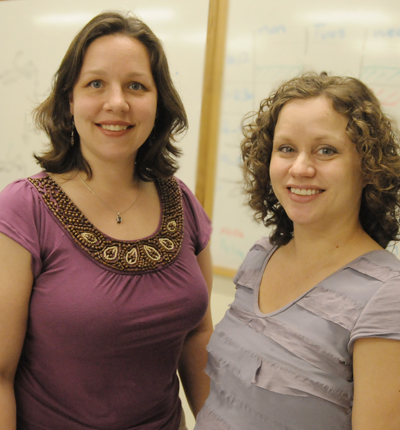Othon, Taylor Design Molecule to Aid Space Travel Ailments

During extended space travel, astronauts may experience dramatic health consequences, such as anemia, due to reduced gravity and exposure to space radiation.
To help combat the adverse effects of space ailments, two scientists at Wesleyan are developing new molecules that enhance cells’ ability to tolerate large swings in pressure, fluid redistribution, temperature and radiation exposure.
Christina Othon, assistant professor of physics, and Erika Taylor, assistant professor of chemistry, assistant professor of environmental studies, received a $20,000 seed grant from NASA’s Biological and Physical Research Enterprise to work on the project titled “Osmoregulation for Microgravity Environments.”
The scientists are taking inspiration from organisms that thrive in extremely hot, acidic or physically severe conditions. These animals, known as extremophiles, use water-regulating molecules known as osmolytes to combat extremes in temperature, hydration and pressure.

By creating chemically modified carbohydrate molecules, the scientists anticipate being able to dramatically alter water dynamics in their newly-designed osmotic molecules. By introducing these new osmolytes near proteins, Othon and Taylor will create a “cage-like environment” around the proteins, eliminating competing hydrogen bonds, and thereby stabilizing the protein structure, even in extreme, anti-gravity environments.
“Ultimately, this could lead to new therapeutic pathways for the deleterious effects of long term space exploration,” Othon says.
Othon, who came to Wesleyan in 2010, worked on similar research at the California Institute of Technology. There, her group discovered a way to alter the movement of water surrounding proteins by adding fluorine. This process made the proteins significantly more stable to chemical and thermal changes.
And at Wesleyan, Taylor is investigating how of sugar molecules attached to a bacterial cell’s surface alter the way the cell interacts with its environment. “In my system, it has been shown that increasing the size of the carbohydrates attached to the surface of a bacterial cell increases the stability of that cell,” Taylor explains.
Since biochemistry and biophysics are closely related disciplines, the cross-department collaboration came naturally for physicist Othon and chemist Taylor. They’re both part of the Molecular Biophysics Program at Wesleyan, an interdepartmental, interdisciplinary program comprised of faculty, postdoctoral research associates, graduate students, and undergraduate students situated in the departments of chemistry, molecular biology and biochemistry, physics and biology.
“Christina and I have many similar interests in understanding how biological systems work, and my hope is that this collaboration can grow toward a joint investigation of small molecule dynamics at the surface of a cell,” Taylor says.

